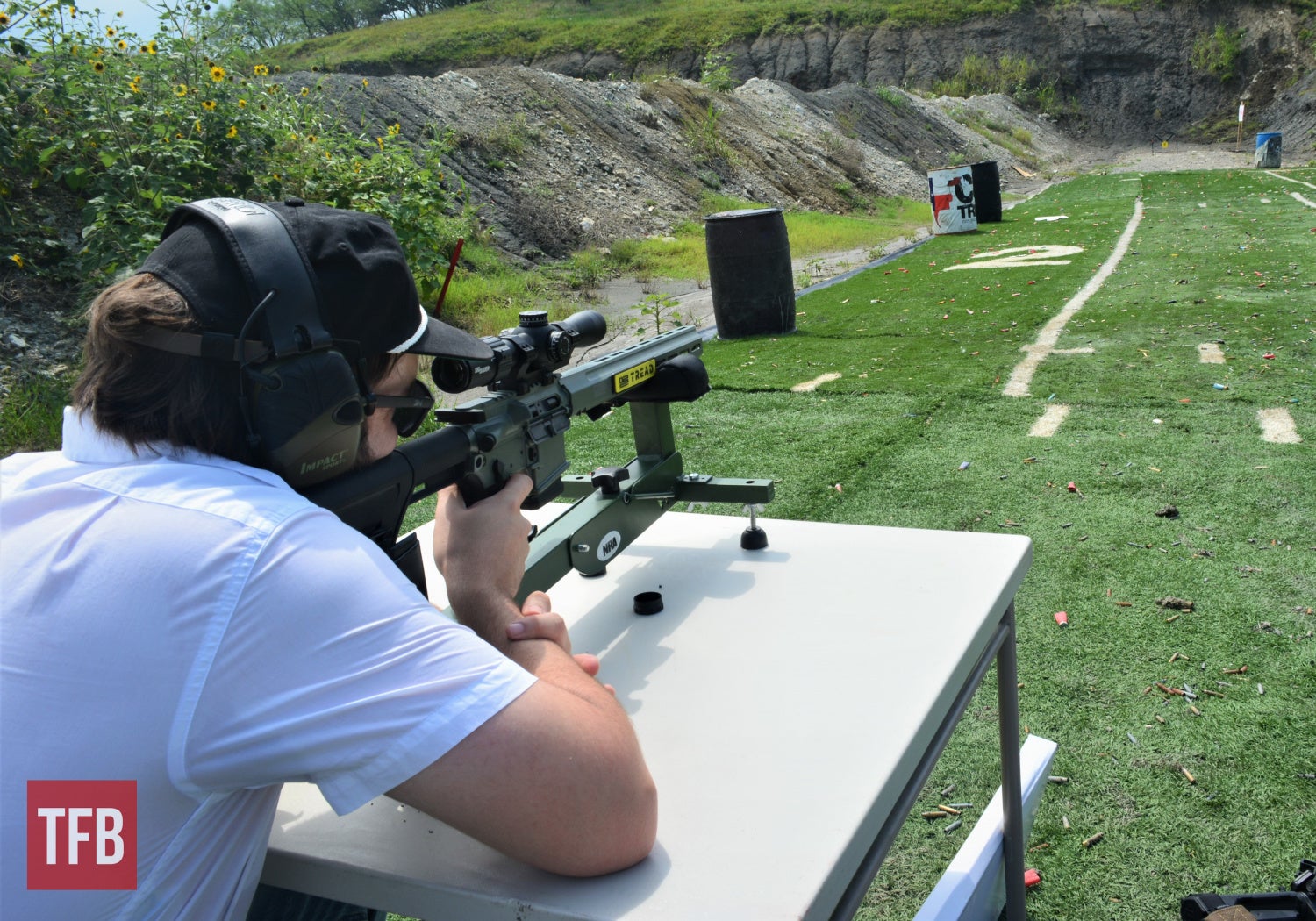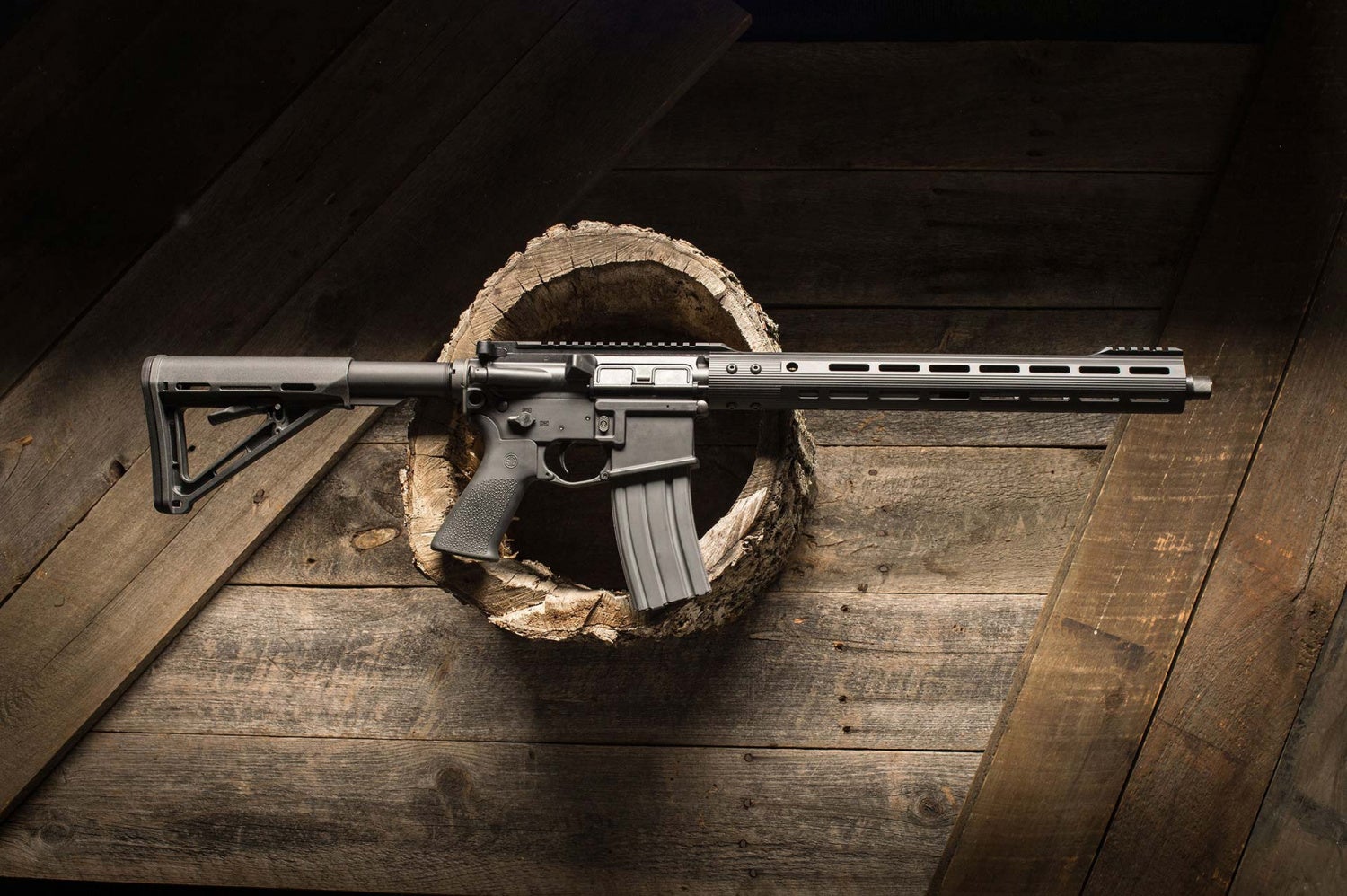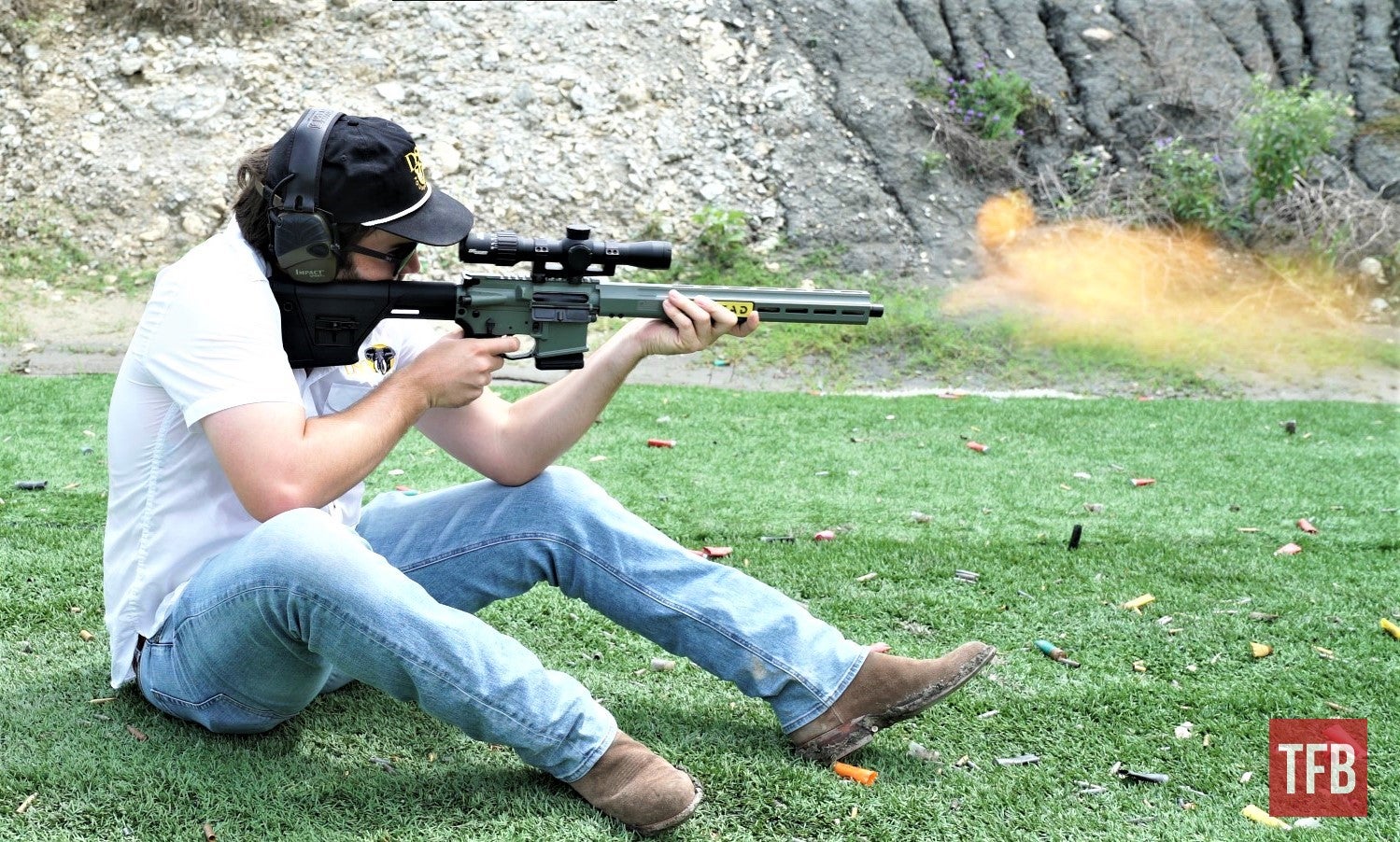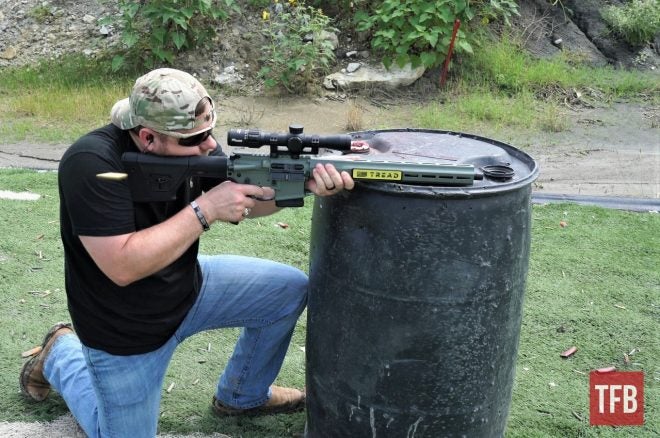SIG SAUER first introduced their M400 series over a decade ago, with the initial version’s release in 2010. The M400 concept was meant to be SIG’s entry into the world of budget-friendly AR-15s. These guns differ from SIG’s pricier rifles like the MCX Virtus Patrol, which is a piston-driven platform, and fall more closely in line with the direct impingement operation that has become generally accepted as “standard” for ARs. Until recently, the series’ current models covered the basics: a regular 16″-barrelled rifle, an 11.5″ pistol, and an upscaled rifle variant that came with some factory upgrades, like an optic and flat trigger. There is also a large-frame cousin, the 716i Tread. This AR-10 shares most of its DNA with the above 5.56 models, but is chambered in 7.62 instead. Never a company to rest on its laurels, SIG is now expanding the M400 family with two new models announced in 2021: the Switchblade (to be covered soon) and the Predator, which I’ve spent the last few months getting to know.
SIG SAUER M400 series guns @ TFB:
- SIG SAUER Announces New TREAD Predator Rifle
- The Switchblade: SIG SAUER Announces New M400 Series AR Pistol
- SIG SAUER Introduces M400 TREAD COIL Rifle
- TFB REVIEW: New Battle Rifle – SIG Sauer TREAD 716i AR-10
- TFB Review: SIG Sauer’s NEW M400 TREAD pistol

A better look at the Predator, with its 16″ barrel inside the atypically squared-off all-MLOK handguard.
The Predator model represents a bit of a departure from the M400 lineup’s extant variants. Whereas the other Tread guns all tend to provide what most shooters would commonly expect in modern AR-15s’ feature sets and configurations, the Predator prefers to buck some of those conventions. Although at its core, it’s still based on the ubiquitous 5.56/.223 gas-operated AR platform that so many of us have come to know and love, SIG has opted to eschew “standard” in some key areas. The most noticeable to me were two: the buttstock and handguard. Rather than the typical telescoping stock on a 6-position buffer tube, the Predator employs a stock system more akin to those often found in precision rifle chassis. Length of pull is adjusted by virtue of a retractable buttpad, and comb height can also be customized. As for the handguard, an atypical squared-off profile was chosen in an effort to maximize stability when resting the gun’s front end on a surface or tools like shooting sticks. The M-LOK fore-end also lacks any Picatinny rail sections, which are normally found running the full length (or at least having several slots toward the muzzle end) of the 12 o’clock top face of an AR’s handguard. The only pic rail segment is found on top of the upper receiver itself.

Some live-fire testing, using a Caldwell rifle gong – the yellow dot at the end of the lane – as our target.
Otherwise, the Predator is familiar to a shooter with AR experience. The construction, function, grip, and controls are all where they’re supposed to be – and props to SIG for including an ambidextrous selector switch, which is an option I always prefer. They’ve also carried over the ambi mag release system from older M400 models, which is less common than the ambi selector. Rounding out the uniqueness is the Predator’s light green “Elite Jungle” Cerakote finish, meant to be suitably subdued in wilderness environments. SIG has made these stylistic and design choices with particular subset of the firearms market in mind: the Predator is supposed to be an AR optimized for hunting – more particularly, for hunting predator animals like coyotes and bobcats, hence the model’s name.

This was SIG’s prior iteration of an AR-15 bearing the Predator title, which was discontinued prior to the new green version.
Interestingly, this is the M400 family’s second iteration of a Predator model intended for hunters. In 2017 they offered a v1 Predator, which was discontinued after a relatively short production run. Unlike this new version, the prior offering was made in .300BLK as well as 5.56, and included a standard telescoping buttstock and round ALG handguard. No doubt the good folks at SIG believe that the updates they’ve chosen this time will better serve the hunting market than the first Predator. Are they right? When they offered to loan TFB one of the new rifles for testing and evaluation, I welcomed the chance to find out.

Zeroing the SIERRA3BDX 2.5-8x32mm scope that SIG sent along with the rifle for our testing purposes.
Upon unboxing, my first impressions were positive. The Predator seemed to be made well, as I would expect from SIG, with good quality fit and finish. Dry firing revealed a nicely crisp and smooth trigger – not match-grade by any means, but for an AR with only a $1099.99 MSRP, no complaints. You could definitely do worse for the price point these days. The handguard and precision-style buttstock were expectedly unusual, but thankfully not clumsy or uncomfortable. I found the stock’s length of pull and comb height adjustments to be easy to manipulate and rock-solid once locked into place. The only apparent miss with that initial inspection was minor: the three branded “Tread” M-LOK panels seemed cheap and flimsy. When I’d first seen them in photos I presumed they were meant to serve as grip attachments, but in reality, they’re just decoration. They rattled loosely, and I’d later discover during live-fire that they actually started to fall apart as their adhesive quickly failed. If you buy a Tread firearm, just take these things off and throw them away. Otherwise, the gun appeared perfectly good to go, and I looked forward to range day.

Examining and marking the first group I shot out of the Predator. After a few more rounds, we were able to get the gun’s groups tightened down a bit and nicely on target.
SIG sent the demo firearm equipped with one of their SIERRA3BDX 2.5-8x32mm scopes in an ALPHA2 30mm mount. To zero this and begin testing, we set the rifle in a bench rest 100m away from a paper target. The gun shot fine, and although we only had a 200-round allotment (thanks a lot, 2020-21 ammo prices) for this review, it cycled all of those with no failures or issues at all. Given the price point, I didn’t necessarily expect it to be a tack driver, but as a hunting gun, it would unquestionably need to be accurate enough to allow clean, ethical kill shots on the user’s intended target species. In the hands of both myself and the other shooter with me, accounting for a brief initial break-in period, we found the Predator tended to consistently produce about 1.5 MOA groups or better. That’s not precision long-range territory by any means, and you can certainly buy 5.56 ARs capable of better, but for that privilege, you’ll usually pay a fair bit more money than this M400 costs. Here again, I was satisfied with the offering within its pricing tier, and it inspired sufficient confidence for the future accomplishment of the gun’s intended taskings. Would MOA or sub-MOA accuracy be preferable? Of course. But could the Predator effectively pop coyotes at apropos distances? Doubtlessly.

I was glad to have snagged this muzzle flash photo while my friend tested the Predator from a seated firing position.
To be frank, before I got my hands on it, I was a bit skeptical about this particular M400. I wasn’t sold on the choices made with the square handguard, the non-standard buttstock, and the chambering for the intended niche. While I do still question the caliber for the reasons delineated above, I’m glad to report that this rifle otherwise exceeded my expectations. Not only did I find the furniture choices not to be a bit awkward and suboptimal, as I’d originally feared they might be, they actually made increasing sense as I used them. Particularly, when I considered the perspective of someone coming into the AR world as unfamiliar territory from traditional hunting guns (which is the opposite of my own experience), I can absolutely see why they might like these particular features. In the course of testing, my initial doubts about this AR gave way to appreciation. It very much grew on me, and I returned the demo rifle to SIG with a markedly increased regard for it.

In addition to other targets, we lit up this Caldwell gong (which had been brand-new out of the box that morning, and solid yellow) with the M400 and my Zastava M90 AK.
Ultimately, the Predator just plain shot well and felt good. Functionality and cycling proved smooth, fit and finish were sound, accuracy was serviceable for the role/cost, and it handled superbly. In all, I think this rifle punches a bit above its weight for the price point and provides good benefits for the money. While its performance won’t blow your mind compared with higher-end ARs, I assess this M400 model to be a solid entry among its more closely-priced competition – at least as good as most others and better than plenty of them. I’ve been a SIG fan for years, and I’d say they got it right again in this case. If you want a respectable AR that won’t break the bank and this one’s particulars tick your boxes in terms of configuration/style choices, I didn’t experience any reason not to recommend it. The Predator offers a solid value proposition in successfully accomplishing what it sets out to do. See you at the range!
Images courtesy of SIG SAUER and the author.
We are committed to finding, researching, and recommending the best products. We earn commissions from purchases you make using the retail links in our product reviews. Learn more about how this works.
 Your Privacy Choices
Your Privacy Choices
